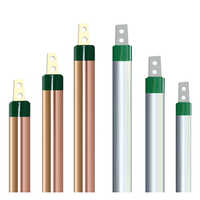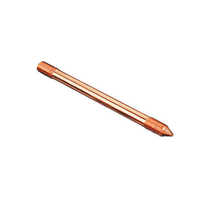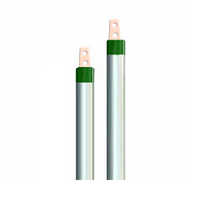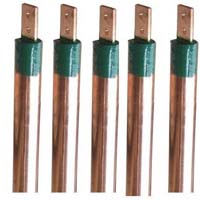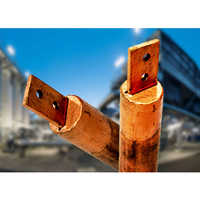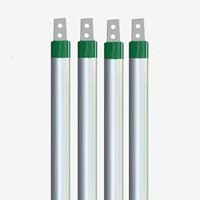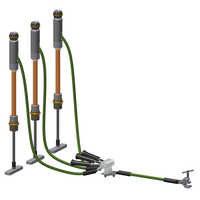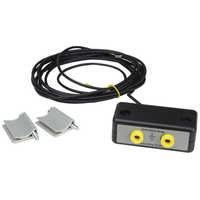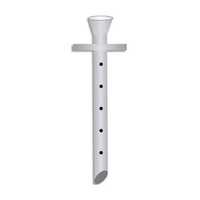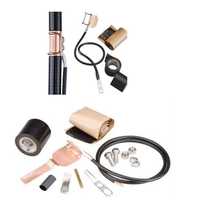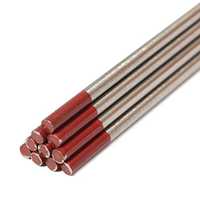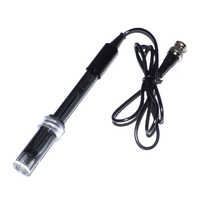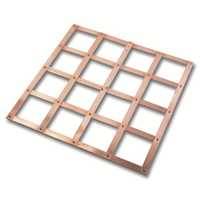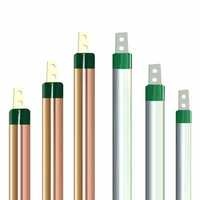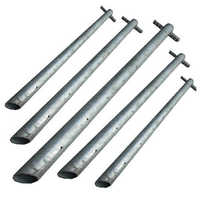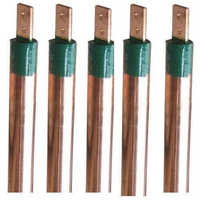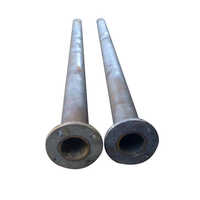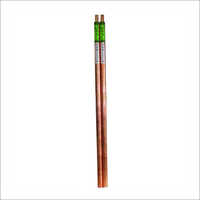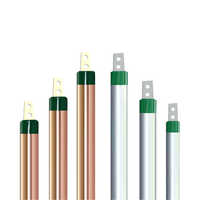Earthing Electrodes
(1168 products)
Earthing electrode price in India starts from INR 500 to INR 10000. Available in different product specifications like dimension: 10 to 25.0 meters (m), weight: 0.6-10 kilograms (kg), application: electricity, colour: grey and can be available as per customers' requirements.
Related Categories
Brass Electrical & Electronic Components
Bulbs & Tubelight
Cable Terminal, Lugs & Socket
Cable Trays
Cables/Cable Accessories & Conductors
Calculator
Capacitors
Chargers
Circuit Boards
Circuit Breaker
Commercial Field
Control Panel Boards
Dc Power Supplies
Decorative Lights
Diesel Generator Sets
Doorbell
ESD Products & Equipment
Earthing Electrodes
Electric Motors & Engines
Electric Power Tools
Electrical / Lighting Products & Components
Electrical Enclosures
Electrical Goods, Equipment & Supplies
Electrical Outlets
Electrical Product Agent
Electrical Safety Products
Electrical Testing & Measuring Equipment
Electrical Transmission Line Goods
Electro Magnets
Electro Stampings
Electronic Data Systems
Electronic Enclosures
Electronic Instrument
Electronic Liquid Level Controllers & Indicators
Electronic Products & Components
Electronic Safe
Electronic Signs & Sign Board
Electronic Testing Equipment
Electronics Agents
Electronics Stocks
Emergency & Safety Lights
Energy Saving Devices
Fibreglass Cable
Financial Field
Flashlights
Flood Light
Frames & Display
Generator Parts & Accessories
Generators
Heat Resistance Wire
Home Automation Systems
Industrial Automation
Insulation Material
Insulation Paper
Inverters & Ups Equipment
Jacks
LED Displays
LED Products
Lamps & Lampshades
Laser
Light Fittings & Fixtures
Lightning Protection System
Mobile Phones, Accessories & Parts
Outdoor Lighting
Plastic Enclosures
Plastic Welding Equipment
Power Cable Accessories
Power Supplies
Power Transmission Equipment
Pressure Switches
Public Address Systems
Radio & TV
Radio & TV Equipment
Rectifiers
Relays
Residential Lighting
Semiconductors
Sensors
Speakers & Speaker Parts
Stainless Steel Wires & Cables
Switchboard
Switches
Switchgear & Allied Products
TV Picture Tubes
Transformer & Transformer Components
Turbine
Voltage Stabilizers
Water Heater
Welding Equipment
Wires/Cables & Accessories
Wiring Harness
Top Earthing ElectrodesCategories
Explore More Categories
Gel Earthing Electrode Application: Industry
Price: 700 INR (Approx.)/Piece
MOQ- 5 Piece/Pieces
3 Years
Shree Shyam Engineering Company
Indian Inquiries Only
GI Earthing Electrode for 25x3 Tape
Price: 3500 INR (Approx.)/Unit
MOQ - 100 Unit/Units
15 Years
Business Type: Manufacturer | Supplier
AXIS ELECTRICAL COMPONENTS (I) P. LTD.
Verified Exporter
( Accepts only Foreign Inquiry)
Copper Chemical Earthing Electrodes
Price: 1900.00 INR (Approx.)/Piece
MOQ - 10 Piece/Pieces
Color - Copper
Product Type - Chemical Electrodes
Material - Copper Bonded Steel
9 Years
Business Type: Manufacturer | Supplier
ZARAL ELECTRICALS
Earthing Electrodes Application: Industrial
Price: 1000.00 - 5000.00 INR (Approx.)/Piece
MOQ - 50 Piece/Pieces
Product Type - Earthing Electrodes
Material - Galvanized Steel
Application - Industrial
8 Years
Business Type: Manufacturer | Distributor
SG POWER
Copper Bonded Earthing Electrode Dimension(L*W*H): Dia - 40Mm
Price: 100.00 - 500.00 INR (Approx.)/Piece
MOQ - 100 Piece/Pieces
Product Type - Copper Bonded Earthing Electrode
Material - Pure Copper
Application - Industrial
8 Years
Business Type: Manufacturer | Exporter
AI EARTHING
Silver Gi Earthing Electrode
Price: 1000 INR (Approx.)/Unit
MOQ - 1 Unit/Units
Color - Silver
Product Type - GI Earthing Electrode
Material - other, Galvanized Iron
6 Years
Business Type: Manufacturer | Exporter
SAFE EARTHING
Polished Finish Corrosion Resistant Hot Rolled Copper Chemical Earthing Electrode For Industrial
Price: 10000 INR (Approx.)/Piece
MOQ - 10 Piece/Pieces
Life Span - Long
Strength - High
Product Type - Earthing Electrode
13 Years
Business Type: Manufacturer | Supplier
Allied Power Solutions
Gunmetal B Bond
Price: 100-350 INR (Approx.)/Piece
MOQ - 500 Piece/Pieces
13 Years
Business Type: Manufacturer | Exporter
VISHNU BRASS INDUSTRIES
Copper Coated Earth Electrode
Price: 18500 INR (Approx.)/Piece
MOQ - 1 Piece/Pieces
Properties - We all know that copper is a very good conductor.Due to its excellent conductive property, it allows more current to flow easily. As there is no corrosion issue, copper lasts longer.Copper earthing electrodes demand very less maintenance. The durability is also impressive.
11 Years
Business Type: Manufacturer | Distributor
ELAPP POWER PRIVATE LIMITED
Round C.I. Earth Electrode Pipe
Price: 700 INR (Approx.)/Meter
MOQ - 100 Meter/Meters
Connection - Other
Shape - Round
14 Years
Business Type: Manufacturer | Exporter
JOY KRISHNA ENGINEERING WORKS
Copper Bonded Rods Application: Earthing
Price: 2,000 INR (Approx.)/Piece
MOQ - 20 Piece/Pieces
Purity - 99%
Product Type - Bonded Rods
Material - Copper Bonded Steel
2 Years
Business Type: Manufacturer | Distributor
SHREENATH ENTERPRISES
Earthing Pipe
Price: 1250.00 - 3500.00 INR (Approx.)/Meter
MOQ - 100000 Meter
2 Years
Business Type: Manufacturer | Distributor
SWASTIK GREEN SOLUTIONS LLP
Industrial Earthing Strap Application: These Products Are Suitable For The Connection Of Dc Resistivity Of Copper Stranded.
Price: 700 INR (Approx.)/Kilograms
MOQ - 20 Kilograms/Kilograms
Product Type - Industrial Earthing Strap
Material - Pure Copper
Application - These products are suitable for the connection of DC resistivity of copper stranded.
3 Years
Business Type: Manufacturer | Exporter
AMA METAL LINK INDIA PVT.LTD
Galvanized Sheet Earthing Electrode
Price: 180 INR (Approx.)/Square Foot
MOQ - 100 Square Foot/Square Foots
Usage - Industrial
Purity - High
Material - Galvanized Sheet
2 Years
Business Type: Manufacturer
ELCON INDUSTRIESS
Galvanized Earthing Electrode Application: Industrial
Price: 100 INR (Approx.)/Kilograms
MOQ - 05 Kilograms/Kilograms
Surface Treatment - Casting
Alloy - Steel
Grade - Industrial
3 Years
Business Type: Manufacturer
PARCO ENGINEERS (M) PVT LTD
Indian Inquiries Only
Indian Inquiries Only
Gel Earthing Electrodes Application: Industrial
Price: 600 INR (Approx.)/Unit
MOQ - 5 Unit/Units
Product Type - Gel Earthing Electrodes
Material - Galvanized Steel
Application - Industrial
2 Years
Business Type: Manufacturer | Supplier
Shree Arihant Enterprises
Indian Inquiries Only
Rectangular Mesh Tem Grids - Copper Diameter: 3.05Mm Diameter Millimeter (Mm)
Price: 12500 INR (Approx.)/Piece
MOQ - 1 Piece/Pieces
Diameter - 3.05mm diameter Millimeter (mm)
Product Type - Rectangular Mesh TEM Grids - Copper
Application - rectangular mesh grids. Copper
7 Years
Response Rate: 91.28%
Business Type: Manufacturer | Supplier
ARITECH CHEMAZONE PVT LTD.
Ashlok Earthing Electrode Copper Thickness: 3.5 Millimeter (Mm)
Price: 8350 INR (Approx.)/Piece
MOQ - 1 Piece/Pieces
Copper Thickness - 3.5 Millimeter (mm)
Material - other, Copper
Weight - 22 Kilograms (kg)
17 Years
Business Type: Manufacturer | Distributor
LINK ELECTRICALS (INDIA)
Indian Inquiries Only
Earthing Electrode
Price: 35.00 - 300.00 INR (Approx.)/Piece
MOQ - 6 Piece/Pieces
7 Years
Business Type: Distributor | Exporter
VIJETHA EARTHING SYSTEM
Indian Inquiries Only
Chemical Earthing Pipe
Price: 330-6900 INR (Approx.)/Unit
MOQ - Any Unit/Units
5 Years
Business Type: Manufacturer | Supplier
PROJECTLINE MATERIALS
Cast Iron Earthing Electrode Pipe Application: Industrial
Price: 5500 INR (Approx.)/Unit
MOQ - 100 Unit/Units
Diameter - 250mm Millimeter (mm)
Product Type - Cast Iron Earthing Electrode Pipe
Application - Industrial
Business Type: Manufacturer | Supplier
Veraizen Earthing
Copper Earthing Electrode Diameter: 50 Millimeter (Mm)
Price: 75.00 - 80.00 INR (Approx.)/Kilograms
MOQ - 10 Kilograms/Kilograms
Diameter - 50 Millimeter (mm)
Product Type - Earthing Electrode
4 Years
Business Type: Manufacturer | Distributor
YASH EARTHING SOLUTIONS PRIVATE LIMITED
Indian Inquiries Only
Black Fitel S177 Electrode
Price: 2500 INR (Approx.)/Piece
MOQ - 100 Piece/Pieces
Purity - High
Product Type - Fitel S177 Electrode
Material - Pure copper
1 Years
Business Type: Service Provider | Trading Company
A. K. TELECOM
Indian Inquiries Only
Copper Gi Chemical Earthing Electrode
Price: 6600 INR (Approx.)/Piece
MOQ - 1 Piece/Pieces
Purity - 99%
Strength - High
Product Type - GI Chemical Earthing Electrode
2 Years
Business Type: Trading Company
SARJU AGENCY
Indian Inquiries Only
Copper Earthing Rod Purity: High
Price: 11000 INR (Approx.)/Piece
MOQ - 100 Piece/Pieces
Purity - High
Material - Pure Copper
Surface Treating - Polished
3 Years
Business Type: Manufacturer | Distributor
U-PROTEC EARTHING PRIVATE LIMITED
Indian Inquiries Only
Silver Gi Earthing Electrode
Price: 5500 INR (Approx.)/Set
MOQ - 1 Set/Sets
Copper Thickness - 3.9 Millimeter (mm)
Diameter - 30-76 Millimeter (mm)
Product Type - Earthing Electrode
7 Years
Business Type: Supplier | Service Provider
BHAWANI ELECTRICAL WORKS
Earthing Electrodes Manufacturers | Suppliers in India
| Company Name | Location | Member Since |
|---|---|---|
| Link Electricals (India) | Delhi, India | 17 Years |
| Sanjay Casting & Engineering Company | Howrah, India | 15 Years |
| Axis Electrical Components (I) P. Ltd. | Mumbai, India | 15 Years |
| Joy Krishna Engineering Works | Howrah, India | 14 Years |
| Allied Power Solutions | Delhi, India | 13 Years |
| Vishnu Brass Industries | Jamnagar, India | 13 Years |
| Elapp Power Private Limited | Kolkata, India | 11 Years |
| Zaral Electricals | Vadodara, India | 9 Years |
| Anssen Metallurgy Group Co., Ltd. | Dalian, China | 9 Years |
| Sg Power | Ghaziabad, India | 8 Years |
Top Related Searches Chemical Earthing Electrodes
What are Earthing Electrodes and How Do They Work?
Through electrical cables and low-resistance wires, earthing is a process or technique that transmits the instantaneous electrical discharge directly to the ground. It can be defined more simply as the straight transfer of electrical charge to the earth. By earthing the system, you can prevent electrical damage and gadget malfunction. When the electrical system overloads, earthing serves the primary goal of reducing the load.
Earthing electrodes are installed and specially created to enhance a system's earthing. To decrease resistance, these earth electrodes should ideally reach the moisture content below the ground.
Additionally, they must be made of metal conductors (or a combination of metal conductor types) that do not corrode too much over the course of the anticipated lifespan. Rods or pipes driven into the ground, metallic plates or mats buried in the earth, or a copper wire ring encircling the building are all examples of earth electrodes.
Different Types of Earthing Electrodes
Earthing Plates
Thin copper plates that are buried in close proximity to the soil are commonly used as grounding plates. According to the National Electric Code, ground plates must have a minimum of 2 ft2 of surface exposed to the earth. Non-ferrous materials (copper) only need to be.060 inches thick; metallic materials must be at least.20 inches thick. Grounding plates are frequently positioned beneath rods or as additional counterpoises.
Concrete-encased or Ufer Ground Electrodes
Ufer grounds were initially concrete-encased copper electrodes that surrounded ammunition shelters. Ufer grounds are any electrodes that are enclosed in concrete, including rebar used as a grounding electrode in a structure foundation or wire or wire mesh embedded in concrete.
A building or Ground Foundation
Ufer Grounds or building foundations may be used as long as the rebar is at least 0.500 inches in diameter, the concrete is in direct contact with the ground (with no plastic moisture barriers), and there is a direct metallic connection from the service ground to the rebar buried inside the concrete.
Water Pipe
Water pipelines have been widely employed as grounding electrodes. Because tar coatings and plastic fittings are used, water line connections are not testable and are unreliable. To stop the passage of current and lessen the corrosive effects of electrolysis, city water departments have started installing plastic insulators, especially in the pipelines. When using water pipes as an electrode, at least one extra electrode must be installed, according to the National Electric Code.
Electric arc discharge
The shortcomings of other grounding electrodes were particularly addressed by the electrolytic electrode's design. This active grounding electrode is made of a copper shaft that is hollow and filled with desiccants and natural earth salts whose hygroscopic nature pulls moisture from the atmosphere. The salts and wetness combine to create an electrolytic solution, which seeps into the nearby backfill material and keeps it moist and rich in ions.
Positive Earthing
Through the use of the GI wire, the neutral of the system is immediately connected to the earth during neutral earthing. System earthing is another name for neutral earthing. Such earthing is typically offered to systems with star winding. For instance, the generator, transformer, engine, etc. all have neutral earthing built in.
The Importance of Proper Earthing for Electrical Safety
To safeguard both building occupants and machinery from the danger of high voltage, grounding your electrical systems is essential. A conductive surface, such as metal, can transport enough voltage to deliver a lethal shock when it is not grounded and electrically energised.
Protection from Electrical Overload
One of the most significant benefits of earthing electrical current is that it shields you and the people you love. Additionally, it shields everyone from electric surges as well as your house's equipment. Whatever the cause, lightning strikes or a power surge at your location could result in extremely high electrical volts within your system and cause damage to your property as well as loss of life.
Aids Electricity Direction
If your home or business has a correct electrical earthing system, you will be able to easily direct power in the desired directions, such as fault current to the earth, and it will also help electrical currents move safely and effectively throughout your electrical system.
Maintains stable voltage values
Voltage levels are stabilised as a result. A grounded electrical system also makes it simpler to spread the right amount of power to all the appropriate locations, which can be extremely helpful in preventing overloaded and blown circuits. For the various power sources in an electrical system, the earth serves as a single point of reference.
How to Select the Right Earthing Electrode?
The dirt resistivity at the location of the earthing system installation should be taken into account when selecting an earthing electrode. You might be able to use a smaller or less costly earthing electrode if the soil resistivity is low because the soil will be able to conduct electricity more efficiently.
Innovations in Earthing Electrode Technology
According to experts., big advancements are on the way, including improving the grounding system's core material. Research and development are already underway, and the products being offered are the best in terms of quality and design. A new generation lightning protection system, a variety of surge protection devices for every purpose, freshly created premium grade chemical mixes, new copper electrodes with amazing new designs, and the list goes on are just a few of these offers.
FAQs: Earthing Electrodes
Q. Why are earthing electrodes necessary?
Ans. Every professional who works with electric equipment abides by the health and safety regulations related to electrical installations and the power sector. When developing intricate electric networks and wiring, earthing segments fall under the category of fundamental safety installations.
Q. How does an earthing electrode work?
Ans. Earthing electrodes play a critical role in two grounding system activities. The first, and riskiest, is dispersing the high amperage of a lightning strike away from the structure into the earth. The fault current from a lightning strike is trying to reach Earth in an effort to balance the potential between the ground and the sky, unlike a typical electrical fault, which has its source in the electrical supply and returns to that same electrical supply.
Q. Can earthing electrodes be installed in all types of soil?
Ans. The soil's electrical resistance is measured by its soil resistivity. A low resistivity is frequently sought because low ground resistance is typically favoured or even required in most applications. The ground resistance itself is not as important in some applications as the grounding configuration. High soil resistivity, however, still poses difficulties for these designs and can exacerbate flaws or under-design.
Related Categories
Related Categories
Brass Electrical & Electronic Components
Bulbs & Tubelight
Cable Terminal, Lugs & Socket
Cable Trays
Cables/Cable Accessories & Conductors
Calculator
Capacitors
Chargers
Circuit Boards
Circuit Breaker
Commercial Field
Control Panel Boards
Dc Power Supplies
Decorative Lights
Diesel Generator Sets
Doorbell
ESD Products & Equipment
Earthing Electrodes
Electric Motors & Engines
Electric Power Tools
Electrical / Lighting Products & Components
Electrical Enclosures
Electrical Goods, Equipment & Supplies
Electrical Outlets
Electrical Product Agent
Electrical Safety Products
Electrical Testing & Measuring Equipment
Electrical Transmission Line Goods
Electro Magnets
Electro Stampings
Electronic Data Systems
Electronic Enclosures
Electronic Instrument
Electronic Liquid Level Controllers & Indicators
Electronic Products & Components
Electronic Safe
Electronic Signs & Sign Board
Electronic Testing Equipment
Electronics Agents
Electronics Stocks
Emergency & Safety Lights
Energy Saving Devices
Fibreglass Cable
Financial Field
Flashlights
Flood Light
Frames & Display
Generator Parts & Accessories
Generators
Heat Resistance Wire
Home Automation Systems
Industrial Automation
Insulation Material
Insulation Paper
Inverters & Ups Equipment
Jacks
LED Displays
LED Products
Lamps & Lampshades
Laser
Light Fittings & Fixtures
Lightning Protection System
Mobile Phones, Accessories & Parts
Outdoor Lighting
Plastic Enclosures
Plastic Welding Equipment
Power Cable Accessories
Power Supplies
Power Transmission Equipment
Pressure Switches
Public Address Systems
Radio & TV
Radio & TV Equipment
Rectifiers
Relays
Residential Lighting
Semiconductors
Sensors
Speakers & Speaker Parts
Stainless Steel Wires & Cables
Switchboard
Switches
Switchgear & Allied Products
TV Picture Tubes
Transformer & Transformer Components
Turbine
Voltage Stabilizers
Water Heater
Welding Equipment
Wires/Cables & Accessories
Wiring Harness
